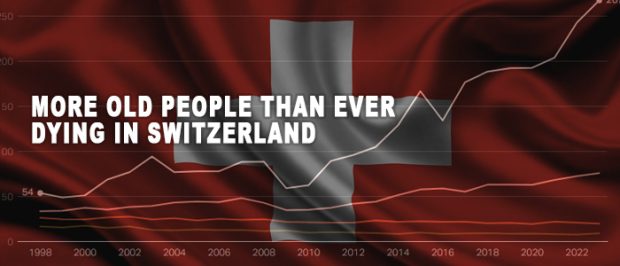July 11, 2025
Suicides in Switzerland quadruple among older people
Suicides in Switzerland quadruple among older people reports Swiss Info
EDITOR’S NOTE: Athanasios Association is the only group who prioritises people who are elderly but not seriously ill.
Read more in Going to Switzerland: how to plan your Final Exit.
Suicides in Switzerland quadruple among older people
A journey of no return: the barbiturate sodium pentobarbital is the drug of choice for euthanasia in Switzerland.

The suicide rate among older people in Switzerland has reached record levels.
The main reason for this is euthanasia.
Other suicides are on the decline, but there is a significant gender difference.
Senior citizens were 42 times more likely to take their own lives in 2023 than people in other age groups, according to Swiss public broadcaster, RTS.
And the numbers are increasing: in the past 25 years, the proportion of over 85-year-olds in Switzerland who decide to take their life has quadrupled.
Among 65- to 84-year-olds, this proportion has doubled.
In contrast, the suicide rate among the younger population has fallen by around 30% in the past two decades.
An analysis of the cases shows that these high figures among senior citizens are largely due to the frequent use of assisted suicide.
Assisted suicide is legal in Switzerland if it is not carried out for selfish reasons.

Why assisted suicide is ‘normal’ in Switzerland
In Switzerland, assisted suicide is considered a legitimate way to end your life.
In the past 25 years, euthanasia has developed rapidly in Switzerland.
The older one gets, the higher the proportion of assisted suicides.
In 2023, around 80% of suicides among 65- to 84-year-olds were assisted, and 90% among those over 85.
Suicide and assisted suicide: related or fundamentally different?
There is controversy among experts as to whether assisted suicides and unassisted suicides can be linked at all.
According to Pierre Vandel, head physician at Lausanne University Hospital, “it is possible to opt for assisted suicide without having suicidal thoughts”.
However, he explains that some of his colleagues make no distinction in this respect.
Euthanasia organisations take a different view.
Suicides in Switzerland quadruple among older people
“Conscious suicides are different from others,” says Jean-Jacques Bise, Co-President of Exit in French-speaking Switzerland.
The figures from RTS suggest that the two types of suicide could be linked.
In very old people, the statistical curves of the two types of suicide cross at the beginning of the 2010s, an indication that from then on there was a shift from unaccompanied to accompanied suicides.
Exit has been offering its members assisted suicide since 1982.
Since 2014, people suffering from multiple illnesses without imminent danger to their lives have also been able to take advantage of this service, provided they are fully capable of judgement.
“We don’t help people who are tired of life,” emphasises Jean-Jacques Bise from Exit.
Is it possible to make use of Exit in cases of depression?
Yes, says Bise, but if a mentally ill person is helped to die, “then because of the illness, not because of the depression”.
According to Pierre Vandel from Lausanne University Hospital, depression and social isolation are the main causes of unassisted suicide in older people.
Differences between the sexes
The figures also show that there are stark differences between men and women. Until the early 2010s, women took their own lives much less frequently than men.
Since then, the number of assisted suicides has also risen sharply among women, and women almost exclusively end their lives in this way of their own accord. In contrast, there is still a comparatively high proportion of unassisted suicides among men.
“Men express their feelings less than women,” explains psychiatrist Pierre Vandel. That is why it is more difficult for them to recognise suicidal thoughts and help them in time. This explains the tendency of men to take their own lives more often without support.